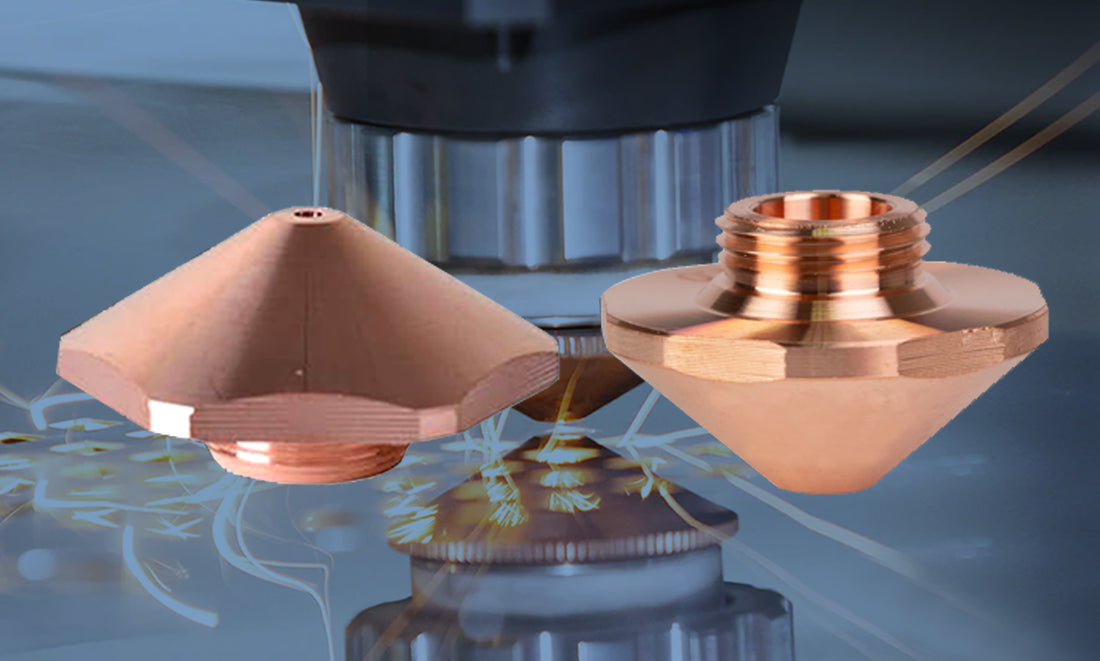
5 Tips for Choosing and Using Laser Cutting Nozzles
Share
5 Tips for Choosing and Using Laser Cutting Nozzles
In laser cutting, the nozzle is a small yet vital component that directly impacts cutting precision, quality, and efficiency. Choosing the right nozzle and using it correctly can significantly enhance your cutting results while ensuring the longevity of your equipment. Here are 5 practical tips to help you select and use laser cutting nozzles effectively.


Tip 1: Selection of laser nozzle type according to the material to be cut
Different materials require specific nozzle designs and assist gas combinations:
- Mild Steel Cutting: Single-layer nozzles with oxygen as the assist gas are ideal, as they promote oxidation to speed up cutting and slag removal.
- Stainless Steel or Aluminum Cutting: Double-layer nozzles paired with nitrogen prevent oxidation and discoloration, producing smooth and clean edges.
- Thicker Materials: Parallel nozzles work best, providing uniform gas flow for deeper, efficient cuts.
Pro Tip: For high-precision or intricate cuts, use conical nozzles for better control of gas flow and precision.
Tip 2: Match Nozzle Diameter with Laser Power
The nozzle diameter determines gas flow intensity and stability. It should align with your laser power and cutting requirements:
- Small Diameter Nozzles: Suitable for thin materials or high-precision cuts, ensuring concentrated gas flow and excellent cutting quality.
- Large Diameter Nozzles: Designed for thicker materials or high-power lasers, they deliver higher gas pressure to clear molten material quickly.
Warning: Using a nozzle that is too small can result in insufficient gas flow, while a nozzle that is too large may reduce cutting precision.
Tip 3: Opt for High-Quality Nozzles
The material and manufacturing quality of the nozzle significantly affect its performance and lifespan:
- High-quality nozzles are made from materials with excellent thermal conductivity, ensuring durability under high heat and pressure.
- Precision-engineered nozzles maintain consistent gas flow and laser beam alignment, minimizing burrs and material damage.
Advice: Avoid cheap, low-quality nozzles as they wear out quickly and may damage your cutting head or reduce efficiency.
Tip 4: Regularly Maintain and Inspect Nozzles
Proper maintenance of the nozzle is essential to ensure consistent cutting performance:
- Clean the Nozzle: After each cutting session, remove debris and slag using a soft cloth or dedicated cleaning tools.
- Inspect for Wear: Check for deformations or damage in the nozzle orifice that could disrupt gas flow or laser beam alignment.
- Replace as Needed: If you notice significant wear or poor cutting results, replace the nozzle immediately.
Pro Tip: Keep spare nozzles on hand to avoid downtime caused by unexpected nozzle damage.
Tip 5: Test and Optimize Laser Nozzle Parameters
Each cutting job may require parameter adjustments for optimal performance:
- Gas Pressure: Adjust the assist gas pressure based on material type and thickness to achieve clean, burr-free cuts.
- Nozzle-to-Workpiece Distance: Maintain an ideal nozzle height, typically between 0.8 to 1.2 mm, to prevent molten material from damaging the nozzle.
- Laser Power Alignment: Ensure the laser power matches the nozzle size to avoid wasted energy or uneven cutting.

Advice: Perform test cuts on scrap material before starting production to fine-tune your parameters and achieve the best results.
Conclusion
Although small, the laser cutting nozzle is a critical component that can make a big difference in cutting efficiency and quality. By following these 5 tips—choosing the right nozzle for the material, matching the diameter with laser power, selecting high-quality nozzles, maintaining them regularly, and optimizing parameters—you can improve your cutting performance and extend your equipment's lifespan.
Have more tips or questions about laser cutting nozzles? Share them in the comments below!
